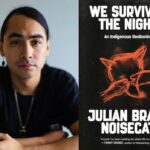First Nation of Na-Cho Nyӓk Dun Elder Walter Peter never imagined he’d see himself as a hologram. But thanks to the wonders of technology, Peter was recently turned into a nearly life-size 3D version of himself. In his small home community of Mayo, Yukon, about a 400-kilometre drive north of Whitehorse, holopresence technology, which captures 3D images or videos of a real person and then projects it as a life-sized hologram, was once unimaginable. Peter said the first time he saw himself as a hologram, it was a pleasant – yet somewhat strange – surprise. “(I said) to myself, ‘how about that, eh? How does that work?’” Now, that very technology is being used to help preserve the First Nation’s language and culture for future generations – with just the tap of a finger. With only about six fluent speakers of Northern Tutchone in the community, Peter said the time is now to safeguard the First Nation’s language and culture. “Our traditional stories and our traditional laws are all fading away, our language too,” he said. That’s why he agreed to lend his wisdom to the project. “Say you got something to share, your story, you share it,” he said. “So, I talked about the culture and our traditional law that was handed down to us that we should follow all the time and make a better life for us all.” The holograms are part of Kwän Dék’án’ Do, a new three-year joint project between Na-Cho Nyӓk Dun, Carleton University and the Office of the Commissioner of Indigenous Languages. Its name means to “keep the fire burning” in Northern Tutchone and entails recording Elders’ stories, oral histories and traditional crafts. There’s even a virtual reality game where Elders voice animals, helping guide learners on a language journey. The idea to use a holopresence machine to showcase Na-Cho Nyӓk Dun’s culture came to life thanks to a working partnership with Carleton University. First Nation of Na-Cho Nyäk Dun Elder Walter Peter stands in front of a hologram of himself. The hologram is part of the First Nation’s new project, Kwän Dék’án’ Do. Photo: Jordan Haslbeck/APTN News Troy Anderson, an associate professor with Carleton’s Sprott School of Business who’s helping lead the project, said the holopresence machine being used – which allows people to appear and interact in 3D – was already in Mayo. It had originally been used to host meetings between the community and students. But Anderson had a better idea. “I suggested maybe we could record oral history – get the Elders to tell their stories as holograms,” he said. “The Elders immediately saw the potential in it and pretty much lined up to tell their stories.” Still, heritage manager Teresa Samson admits some Elders were skeptical of the project at first, concerned their sacred traditional knowledge would be up for grabs for anyone to access. But the project itself limited to Na-Cho Nyäk Dun citizens, though it can also be viewed on the holopresence machine located in the First Nation’s government office. “People are understanding more of what it is that we’re trying to do,” Samson said. “They’re engaged and they want to participate and they want to find out how they can be involved, and they’re excited, and that makes me very happy.” “We’re not only teaching kids that you can go on a language journey that is fun, but we’re preserving our history and our culture in our own way, and making sure that there is a legacy left for the kids that are coming behind us,” she added. First Nation of Na-Cho Nyӓk Dun Heritage Manager Teresa Samson stands in front of the start screen for the Kwän Dék’án’ Do project on the holopresence machine. Photo: Jordan Haslbeck/APTN News Project just getting started The project is still growing. More cultural activities and elements will be added, including the use of AI to preserve the Northern Tutchone language. AI will eventually be used to help with language learning and even construct new vocabulary. Anderson said Na-Cho Nyäk Dun’s unique Northern Tutchone dialect isn’t readily available for AI to learn from just yet. “What we have to do is digitize everything we can find, every asset we can find. We have to digitize old recordings on cassette tapes, things that are found in collections at universities,” he said. “Then once that is all gathered together, then AI can learn ‘What is Northern Tutchone? How does it work? What are the grammar rules?’ And eventually (it will) learn to speak.” Prof. Troy Anderson with Carleton University is helping lead the project. Photo: APTN News Citizens can also access the project online, though the holopresence machine makes the experience a lot more immersive. No matter how citizens engage with it, the goal isn’t to replace traditional language learning, but to complement it. “You cannot pack those things around in the bush,” Peter said. “You gotta learn up here, you gotta keep it here,” he said, pointing to his head and heart. Once the project is complete, its model will be made publicly available so other Indigenous communities around the world can create their own, though Na-Cho Nyäk Dun’s own cultural content will remain off limits. For Peter, the best way to preserve his culture is to share it, and through the hologram, that’s exactly what he’s doing. “When I’m long gone, I’ll be sitting there like I am today.” Continue Reading
Keep the fire burning: Na-Cho Nyäk Dun turns to holograms and AI to help preserve its language

Leave a Comment










